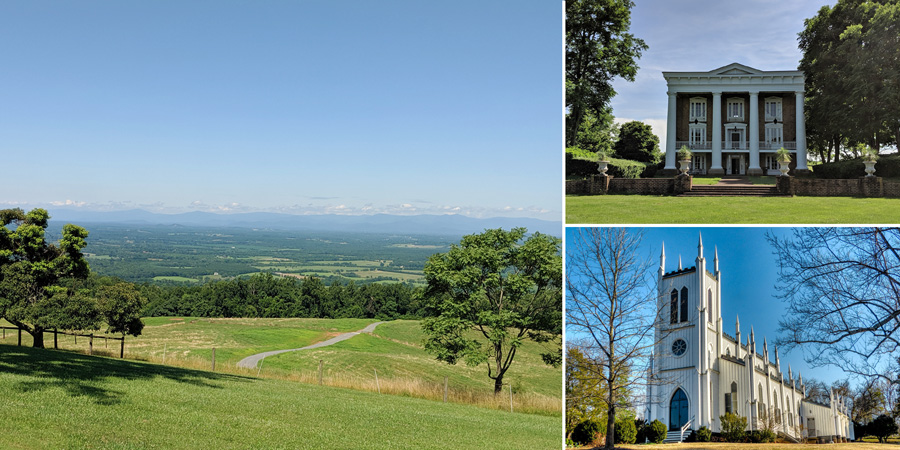
Updated September 4, 2025
What is the Rapidan River-Clark Mountain Rural Historic District?
The Rapidan River – Clark Mountain Rural Historic District is a nearly 40,000-acre historic landscape in Orange County and parts of Madison and Culpeper Counties that has been determined eligible for listing on the Virginia Landmarks Register and the National Register of Historic Places for its high concentration of historic resources dating from the prehistoric period through the 1930s.

Why is this particular area significant?
The district contains a wide range of historic sites, from grand houses like Meander (c.1766), Greenway (c.1788) and Brampton (c.1846), to the Hopewell Baptist Church (c.1881), the Rapidan Train Depot (c.1876) and Taylor Sylvania Barn (c.1920) to remnants of the Civil War era Rapidan Line and sites associated with early Native American groups that once resided in the area.
The resources are important for their association with broad patterns of history with areas of significance including the Civil War, agricultural history, industry, geography and hydrology, and social history, including early settlements, African-American communities, 20th-century migration patterns.
The resources are locally significant for their distinctive characteristics of construction, but also for the aesthetic created by the surviving patterns of agricultural fields and riverine woodlands flanking the waterway, dotted with a mix of domestic and agricultural architectural survivals ranging from high style to vernacular buildings. The proposed district also has the potential to yield important information about the period prior to contact with European settlers as well as the early settlement period in the area.
What are the benefits of the district?
There are a number of benefits associated with the creation of a rural historic district. First, landowners of properties within a listed rural historic district can use historic preservation as a qualifying purpose under the IRS regulations, when taking a charitable deduction for a conservation easement.
Second, the process of creating a rural historic district is a powerful place-making tool, that educates residents and landowners within the proposed district about the history of their property, leading them to develop a better understanding about its significance and deeper pride in their property.
Third, Virginia Code requires the SCC to minimize impacts to historic districts when siting transmission lines.
Taken together, the benefits of rural historic districts associated with the discouragement of transmission line siting, qualifying purpose under IRS regulations and increased pride of place are very strong motivators for future conservation.
In the more than 25 years since the nearby Madison-Barbour and Southwest Mountains Rural Historic Districts were listed, levels of conservation in these areas have grown to more than 40% of the districts being protected.
Following a listing of the Rapidan River-Clark Mountain RHD on the National Register of Historic Places, we expect to see increased levels of conservation within the district, a broader understanding and appreciation of the history of the area and the resources encompassed within it.
Is my property in the proposed district?
This map shows the area covered by the proposed historic district. Take a look to see if your property is included – click the image to view larger.
Are there restrictions on altering my property?
No! The district is solely an honorary designation, shining light on the historic significance of the area. It does not prohibit property owners from doing anything to their property. Only locally designated historic districts are subject to local zoning ordinances and procedures. Visit our page on Local Historic Districts for more information. However, there are several real benefits associated with a historic district listing.
What is the process for creating the district?
The Piedmont Environmental Council, through a combination of grants and private funding, raised the money to hire a consultant to complete a Preliminary Information Form (PIF) for the proposed district, and guide that PIF through the evaluation process with the Virginia Department of Historic Resources.
The district was determined eligible for listing in the Virginia Landmarks Register and National Register of Historic Places in September 2017. In order to have the register-eligible district listed on both the state and national registers we now need to complete a full nomination.
The complete Preliminary Information Form is attached here.
PEC has hired the Fairfield Foundation of Gloucester, Virginia to complete the survey and nomination work for the district. The survey work for the district entails visiting every property in the district to create an accurate documentation of all of the resources that exist on the property – essentially a snapshot in time. The documentation is important – if anything should happen to the resources over time due to fire, neglect or bulldozer, the perpetual record is there.
*Learn more about the district and nominating process by watching the recording of our virtual community meeting in November, 2021:
What happens next?
After all of the records for surveyed properties in the district have been completed, the consultants will begin work on the narrative portion of the National Register nomination for the district. This section of the nomination describes the historic significance of the district, important contributing resources and ties those resources and their significance to certain themes, such as agriculture, architecture, conservation, settlement and more.
There will be opportunities for public comment at upcoming public meetings. Following the final public meeting, the draft nomination will be presented to the Virginia Board of Historic Resources for consideration at a public meeting, likely in 2026. If you would like to receive email updates about the next steps for the district, as well as other current land use matters in Culpeper, Madison, and Orange, you can sign up for updates here.
In the meantime, please feel free to contact Don McCown, Land Use Field Representative for Madison and Orange Counties, with any questions at [email protected] or (434) 977-2033, x7047.


